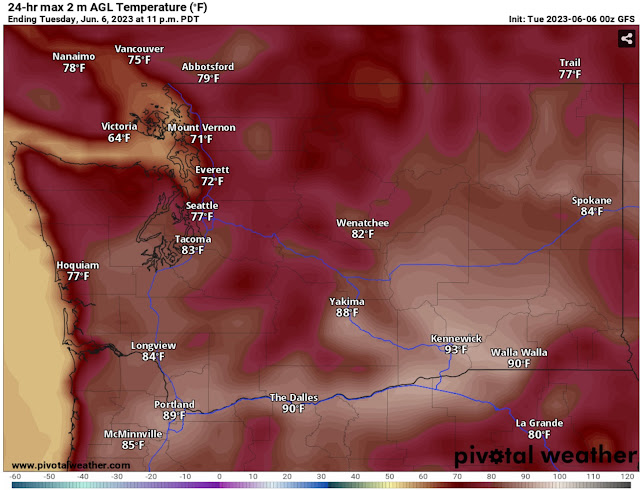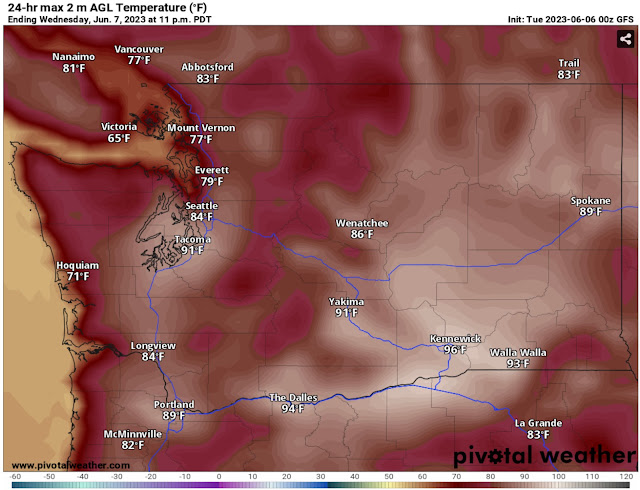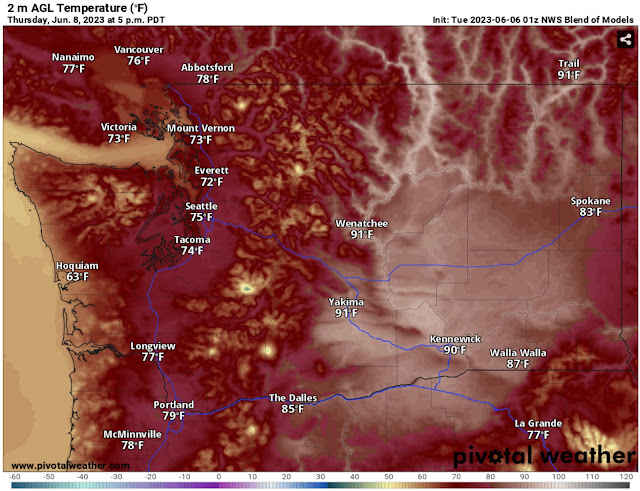FastCast—Tuesday, June 6 to Saturday, June 10:
A significant warmup is ahead for Washington state from Tuesday to Thursday. On Tuesday, expect lowland highs to increase into the mid 70s to low 80s. Wednesday will be by far the hottest day, with highs in the upper 70s to low 80s near the water and in the mid to upper 80s elsewhere. There is a slight chance of highs reaching the low 90s for isolated locations in the lowlands, most likely closer to the foothills. Thursday will still be warm, but with increasing high clouds and highs dropping to the mid 70s to low 80s, with some readings in the mid 80s. Throughout this time, expect lows in the low to mid 50s. Additionally, due to recent dry & gusty winds and low relative humidity, a Red Flag Warning is in effect for the South & Central Cascades, and there is elevated fire danger across the lowlands. Remember to be very careful when burning or handling anything that can cause a fire. Any fires that start can spread rapidly in these conditions.
———————————————————
Continue reading the full blog below!
A big increase in temperatures is ahead for the entire state from Tuesday to Thursday, with temperatures on Wednesday being quite hot. Let’s take a look at the forecast. This forecast will compare the GFS model and higher-resolution NWS NBM model. The GFS trends on the warmer side, while the NWS NBM trends a bit cooler. It is important to see both forecasts to get an accurate prediction of what’s possible.
First, Tuesday’s highs from the GFS model.
Expect highs around the lowlands in the mid 70s to low 80s, except in the low to mid 70s near the water, especially in the North Sound. The coast will reach the mid 60s to mid 70s, and areas from Olympia south will reach the low to mid 80s, except for the Willamette Valley, where highs will reach the upper 80s. Eastern Washington will warm into the low 80s to low 90s.
Let’s compare the GFS forecast to the higher-resolution NWS NBM forecast, seen below.
The NBM increases the effect of the Sound Breeze around the lowlands, showing highs in the mid to upper 70s, with the valleys and foothills reaching the low 80s. This forecast shows highs in the low to mid 80s from Olympia to Longview, and in the upper 80s to low 90s from Longview south into the Willamette Valley. Also note highs in the low to mid 70s on the coast and in the upper 80s to mid 90s in Eastern Washington.
Next, let’s take a look at the forecasts for Wednesday (the hottest day of this stretch), starting with the GFS model.
The GFS shows highs in the low 80s to low 90s in the lowlands (upper 70s to low 80s near the water), likely overdone by a few degrees (peak temperatures are more likely to be in the upper 80s). Expect highs on the coast in the mid 60s to low 70s, and in the mid 80s to low 90s from Olympia southward to Portland. Eastern Washington will still be getting hotter, up to the mid 80s to mid 90s.
Let’s compare with the higher-resolution NWS NBM forecast for Wednesday, seen below.
This forecast shows highs in the lowlands reaching the low to mid 80s, except in the upper 70s near the water. Some areas east of I-5 may reach the upper 80s to low 90s in this “cooler” scenario for the lowlands. Areas along the I-5 corridor from Olympia south will reach the mid to upper 80s, and the coast will cool off some, down to the mid to upper 60s. In this forecast, Eastern WA is baking, with highs in the mid to upper 90s!
Thursday will bring a slight cooldown across the state, mainly west of the Cascades. Below is the GFS forecast.
Lowland highs will decrease to the low to mid 80s, except in the mid 70s near the water. Expect the coast to drop to the mid 60s, and areas from Olympia to Portland to drop to the upper 70s to mid 80s. Eastern WA will remain warm, likely in the mid 80s to mid 90s.
Let’s compare to the NWS NBM for Thursday, seen below.
The NWS NBM forecast shows a larger cooldown for areas west of the Cascades, dropping the entire I-5 corridor to the mid to upper 70s (except low 70s near the water), and dropping the coast to the low to mid 60s. Eastern WA will drop to the mid 80s to low 90s in this forecast.
One final note…fire danger is higher than normal due to a few days of dry & breezy northerly winds and the associated low relative humidity. Because of this, a Special Weather Statement for elevated fire danger has been issued for the lowlands (light tan shading) and a Red Flag Warning has been issued for the South & Central Cascades (magenta shading), seen below on the NWS Seattle map.
These dry conditions have already caused multiple brush fires around the region, including in Bothell, Graham, and Vancouver (WA).
A sampling of minimum relative humidity values on Monday can be found below. Note that most areas around the lowlands dropped to 20-35% humidity, with locations from Bremerton/Poulsbo to Olympia even lower, in the 8-20% range.
Seeing these values so early in the season helps to dry out vegetation (known as “fuels” when referring to fires). Continued dry conditions will be something to keep a close eye on as peak fire season approaches.









Sounds like summer for the next couple days, hope we are not going to complain about the heat, after we complained about the cold weather.
ReplyDelete